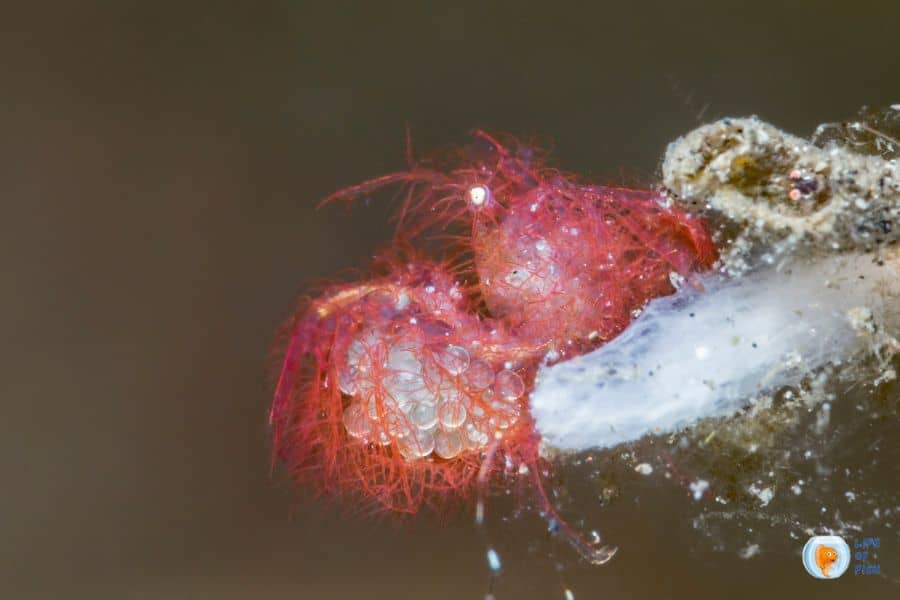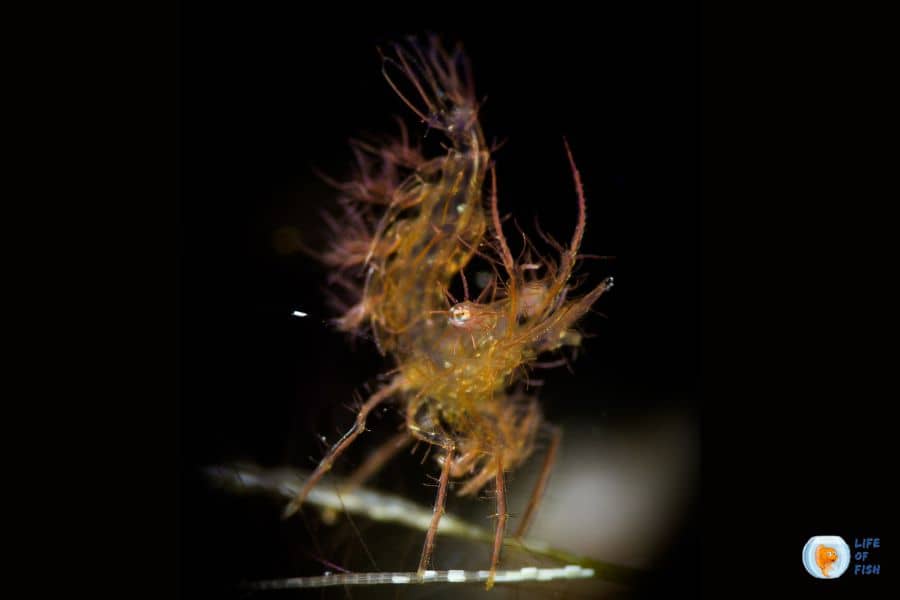I first saw this tiny shrimp in a picture my diver friend took. I thought they were like a pomeranian version of shrimps. According to my friend, they are known as hairy shrimp and they are very hard to find because of their excellent ability to hide under seagrass or among algae. Naturally, I wanted to learn more about this amazing sea animal. Unfortunately, there was very little about them on the internet. So I searched in books and gathered a little bit of information available. In this article, I would like to share those details with you. So let’s dive in.
Hairy Shrimp or phycocaris simulans is also known as Algae Shrimp. The reason to call it Algae shrimp is it resembles a very tiny piece of Algae. They are one of the freakiest creatures around the Lembeh Strait. This tiny animal is normally found in between tunicates and ascidians or Algae. Sometimes on rocks and coral rubble.

What is Hairy shrimp?
Jump To
You can find them in many colors. They can be brown, white, red, greenish, or even yellow. It is hard to identify them when they are in their natural environment due to these colors closely matching the color of algae. The prominent feature of their body is their hair. It grows all over the body. That’s why I told them about the Pomeranians in the shrimp family. This tiny but dense hair of their body camouflages them. The combination of their colors and their hairy body makes them really undistinguished when they are in their natural environment.
Another important feature of this shrimp’s body is its tail. The tail stands high like a swan. They are not active swimmers and usually try to stay in the same area. As shrimp, they can swim. But these shrimp do not actively swim. They usually drift with a surge by wagging their body. Most of the time the females of this species carry eggs and if you have a good macro lens you can see their egg sacs. But they are very tiny and attached to the belly of the female shrimp. They have ray-like lines around their eyes which make them look like the sun. Hairy shrimp is an eye-catcher to marine enthusiasts because of their interesting features.
Genus Phycocaris (family Hippolytidae) have only one species and is Phycocaris simulans . Phycocaris simulans were first identified and recorded by Kemp in 1916. He found them from the Andaman Islands. And then in 2017 Gan and Li recorded and described them from Hainan Island in the South China Sea. They are not evaluated by IUCN and they believe there is no threat to hairy shrimp (for now).

Where do Hairy shrimp come from?
They are native to Southeast Asia and prominent near Lembeh Strait, Indonesia. Besides, their geographic distribution comprises the Andaman Islands, Heron Island and Darwin, Australia, Kume Island, Japan, Hainan Island and China. They can be found between 3-5 meters from the water surface. However, some divers claimed that hairy shrimp could also be found at depths of 20 m.
Is Hairy shrimp aggressive?
Unfortunately, I could not find any details on whether they are aggressive or not. They seem peaceful and timid. But without further details, we can not conclude that.
Hairy shrimp behavior
Hairy shrimp is not an active species and they spend most of their time staying among the algae. They do not usually swim and move right and left with the surge. As they are very small and have perfect camouflage with their tiny hairs and colors which match the algae, they cannot be easily identified by their enemies.

Hairy shrimp size
The hairy shrimps are very small creatures and the size of them vary from 1mm to 5mm (the size of rice grain). The maximum length reported is 5mm and most of the hairy shrimp found are smaller than 5mm.
Lifespan
According to research, the normal lifespan of hairy shrimp is less than two years.
Can we keep hairy shrimp in an aquarium?
Due to various reasons, they are not suitable to keep in aquariums. The most important reason is their tiny size. They will be a very easy snack for larger fish and other shrimps. You can not provide enough hiding space for this shrimp in a community tank. Other than that they will entangled in your filter system if you try to keep hairy shrimp in an aquarium.
What do Hairy shrimp eat?
The main diet of hairy shrimp is algae. That is why it is always found near algae outgrowths. They also eat dead and living plants and other detritus matter available in the water. However, They cannot eat large food particles.
What fish can live with Hairy shrimp?
In an imaginary situation, if you keep hairy shrimp in an aquarium, you need to be very careful about the fish species you keep with them. They are very small and can be fed to other fish at any time if you don’t select the correct tank mate. However, hairy shrimps will not harm or bully other fish species.
Many reef fishes, for example, feed on crustaceans like marine shrimp as part of their natural diet. Some of the fish like angelfish, cardinalfish, damselfish, butterflyfish, blennies, wrasses, dragonets, rabbitfish and surgeonfish may not bother shrimp a lot. Certain species of marine fish like dottybacks, larger cardinalfish, and pseudochromis are potentially dangerous to shrimp, though smaller specimens of these species are unlikely to be a problem.
Some fish that are almost always a threat to shrimp include rays, morays, sharks, coral catfish, toadfish, lizardfish, squirrelfish, groupers, comets, goatfish, snappers, hawkfish, tilefish, triggerfish, and puffers. Avoid keeping marine shrimp in a tank with any of these species.

Conclusion
Hairy shrimp are very small marine shrimp. Many marine life enthusiasts try to capture them with their cameras when they are in their natural environment. It is not easy to recognize them as they perfectly camouflage themselves with their body color and tiny hair all over their body. There is no clue that you can keep them in an aquarium. By any chance, if you keep them in an aquarium you need to be very careful as they may get tangled in your filters as they are very tiny.
Read Next : Best Substrate For Corydoras (You Must Know This)
